Seine-Saint-Denis
Seine-Saint-Denis (French pronunciation: [sɛn sɛ̃ d(ə)ni]) is a department of France located in the Grand Paris metropolis in the Île-de-France region. In French, it is often referred to colloquially as quatre-vingt treize or neuf trois ("ninety-three" or "nine three"), after its official administrative number, 93. Its prefecture is Bobigny.
Seine-Saint-Denis | |
|---|---|
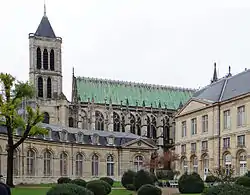 | |
 Flag  Coat of arms | |
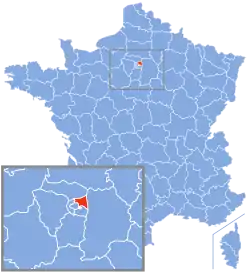 Location of Seine-Saint-Denis in France | |
| Coordinates: 48°54′N 02°29′E | |
| Country | France |
| Region | Île-de-France |
| Prefecture | Bobigny |
| Subprefectures | Le Raincy Saint-Denis |
| Government | |
| • President of the Departmental Council | Stéphane Troussel[1] (PS) |
| Area | |
| • Total | 236 km2 (91 sq mi) |
| Population | |
| • Total | 1,655,422 |
| • Rank | 4th |
| • Density | 7,000/km2 (18,000/sq mi) |
| Time zone | UTC+1 (CET) |
| • Summer (DST) | UTC+2 (CEST) |
| Department number | 93 |
| Arrondissements | 3 |
| Cantons | 21 |
| Communes | 40 |
| ^1 French Land Register data, which exclude estuaries and lakes, ponds and glaciers larger than 1 km2 | |
In 2019, it had a population of 1,644,903 across 40 communes.[3] In French, the learned but rarely used demonym for the inhabitants of Seine-Saint-Denis is Séquano-Dionysiens; more common is Dionysiens.
Geography
The department is surrounded by the departments of Hauts-de-Seine, Val-de-Marne, Paris, Val-d'Oise, and Seine-et-Marne. It is thus the only one of the five French departments surrounded entirely by other departments of the same region.
Seine-Saint-Denis is located to the northeast of Paris. It has a surface area of only 236 km² (91 sq mi), making it one of the smallest departments in France. Seine-Saint-Denis and two other small departments, Hauts-de-Seine and Val-de-Marne, form a ring around Paris, known as the Petite Couronne ("little crown"). Since 1 January 2016, together with Paris, they have formed the area of Greater Paris (Grand Paris).
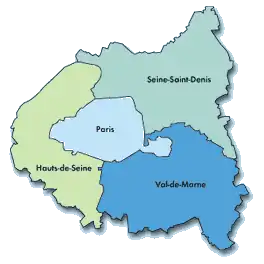
Principal towns
The most populous commune is Saint-Denis; the prefecture Bobigny is the eleventh-most populous. As of 2019, there are 5 communes with more than 70,000 inhabitants:[3]
| Commune | Population (2019) |
|---|---|
| Saint-Denis | 112,852 |
| Montreuil | 111,240 |
| Aubervilliers | 88,948 |
| Aulnay-sous-Bois | 86,969 |
| Drancy | 72,376 |
History
Seine-Saint-Denis was created in January 1968, through the implementation of a law passed in July 1964. It was formed from the part of the (hitherto larger) Seine department to the north and north-east of the Paris ring road (and the line of the old city walls), together with a small slice taken from Seine-et-Oise.
Seine-Saint-Denis has a history as a left-wing stronghold, belonging to the ceinture rouge (red belt) of Paris. The French Communist Party has maintained a continued strong presence in the department, and still controls the city councils in cities such as Saint-Denis, Montreuil and La Courneuve. Until 2008, Seine-Saint-Denis and Val-de-Marne were the only departments where the Communist Party had a majority in the general councils but the 2008 cantonal elections saw the socialists become the strongest group at the Seine-Saint-Denis general council (while the Communist Party gained a majority in Allier and lost it in 2015).
A commune of Seine-Saint-Denis, Clichy-sous-Bois, was the scene of the death of two youths which sparked the nationwide riots of autumn 2005. In October and November, 9,000 cars were burned and 3,000 rioters were arrested.
In 2018, the department had the highest crime rate in metropolitan France.[4] In 2017, the area was the location of 18% of all drug offences in metropolitan France.[4]
Demographics
Seine-Saint-Denis is the French department with the highest proportion of immigrants: 21.7% at the 1999 census (see table below). An immigrant according to INSEE is anyone born non french in or outside France and as such, this figure does not include people born french but with a migrant background or from overseas France. The ratio of ethnic minorities is difficult to estimate accurately as French law prohibits the collection of ethnic data for census taking purposes.
In 2018, the poverty rate was twice the national average at 28%, the unemployment rate was 3 per cent above the national average and 4 percentage points above the Île-de-France average at 12.7%. In 2018, it was estimated that 8–20% of the population in the department were illegal immigrants.[5]
Population development since 1881:
|
| ||||||||||||||||||||||||||||||||||||||||||||||||||||||||||||
| Sources:[6][7] | |||||||||||||||||||||||||||||||||||||||||||||||||||||||||||||
Education
An education study confirmed falling levels of literacy in the area, where the percentage of pupils who had 25 errors or more increased from 5.4% in 1987 to 19.8% in 2015.[4]
Place of birth of residents
| Born in metropolitan France | Born outside metropolitan France | |||
|---|---|---|---|---|
| 72.5% | 27.5% | |||
| Born in overseas France |
Born in foreign countries with French citizenship at birth1 | EU-15 immigrants2 | Non-EU-15 immigrants | |
| 3.1% | 2.7% | 4.4% | 17.3% | |
| 1 This group is made up largely of former French settlers, such as Pieds-Noirs in Northwest Africa, followed by former colonial citizens who had French citizenship at birth (such as was often the case for the native elite in French colonies), as well as to a lesser extent foreign-born children of French expatriates. A foreign country is understood as a country not part of France in 1999, so a person born for example in 1950 in Algeria, when Algeria was an integral part of France, is nonetheless listed as a person born in a foreign country in French statistics. 2 An immigrant is a person born in a foreign country not having French citizenship at birth. An immigrant may have acquired French citizenship since moving to France, but is still considered an immigrant in French statistics. On the other hand, persons born in France with foreign citizenship (the children of immigrants) are not listed as immigrants. | ||||
Politics
The president of the Departmental Council is Stéphane Troussel, first elected in 2012.
Presidential elections 2nd round
| Election | Winning Candidate | Party | % | 2nd Place Candidate | Party | % | |
|---|---|---|---|---|---|---|---|
| 2022[8] | Emmanuel Macron | LREM | 73.72 | Marine Le Pen | FN | 26.28 | |
| 2017[9] | Emmanuel Macron | LREM | 78.82 | Marine Le Pen | FN | 21.18 | |
| 2012 | François Hollande | PS | 65.32 | Nicolas Sarkozy | UMP | 34.68 | |
| 2007 | Ségolène Royal | PS | 56.54 | Nicolas Sarkozy | UMP | 43.46 | |
| 2002[9] | Jacques Chirac | RPR | 82.56 | Jean-Marie Le Pen | FN | 17.44 | |
| 1995[10] | Lionel Jospin | PS | 51.84 | Jacques Chirac | RPR | 48.16 | |
Current National Assembly Representatives
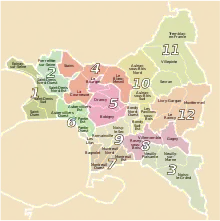
Tourism
References
- "Répertoire national des élus: les conseillers départementaux". data.gouv.fr, Plateforme ouverte des données publiques françaises (in French). 4 May 2022.
- "Téléchargement du fichier d'ensemble des populations légales en 2020". The National Institute of Statistics and Economic Studies. 29 December 2022.
- Populations légales 2019: 93 Seine-Saint-Denis, INSEE
- "N° 1014 - Rapport d'information de MM. François Cornut-Gentille et Rodrigue Kokouendo déposé en application de l'article 146-3 du règlement, par le comité d'évaluation et de contrôle des politiques publiques sur l'évaluation de l'action de l'État dans l'exercice de ses missions régaliennes en Seine-Saint-Denis". www.assemblee-nationale.fr. Retrieved 2018-07-08.
- "Immigration clandestine : la Seine-Saint-Denis débordée". FIGARO (in French). 2018-07-04. Retrieved 2018-07-08.
- "Historique de la Seine-Saint-Denis". Le SPLAF.
- "Évolution et structure de la population en 2016". INSEE.
- "Les résultats du second tour de l'élection présidentielle". 19 April 2022.
- "Présidentielles".
- "Résultats de l'élection présidentielle de 1995 par département - Politiquemania".
- Nationale, Assemblée. "Assemblée nationale ~ Les députés, le vote de la loi, le Parlement français". Assemblée nationale.
Further reading
- Bédarida, Catherine (29 September 2008). "Seine-Saint-Denis, naissance d'un ghetto" [Seine-Saint-Denis, birth of a ghetto]. Le Monde.
- Kefi, Ramses (30 January 2015). "Pourquoi toujours le 9-3 ?" [Why is it always Seine-Saint-Denis?]. L'Obs.
External links
- Seine-Saint-Denis Departmental Council (in French)
- Prefecture website (in French)
- Seine-Saint-Denis Tourist Board
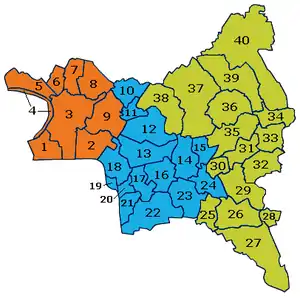


.jpg.webp)




